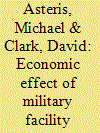|
|
|
Sort Order |
|
|
|
Items / Page
|
|
|
|
|
|
|
| Srl | Item |
| 1 |
ID:
158443


|
|
|
|
|
| Summary/Abstract |
The global financial turmoil of 2008 has resulted in the curtailment of military expenditure in most western countries. At a sub-regional-level reductions in the level of activity at a major military facility can have significant economic impact. In the light of this, the paper has two objectives: to analyse the impact of the decision to terminate naval shipbuilding at the United Kingdom’s Portsmouth Naval Base; and, for illustrative purposes, to examine the possible economic consequences of further contraction at the facility. In pursuit of these aims, it is necessary to establish the output, income and employment generated by the base using a bespoke input–output model. The methodology employed can, with appropriate adjustments, be utilised in other military or civilian contexts.
|
|
|
|
|
|
|
|
|
|
|
|
|
|
|
|
| 2 |
ID:
158444


|
|
|
|
|
| Summary/Abstract |
This paper empirically investigates the impact of military base realignments and closures on regional economic activity in light of the 2005 round of Base Realignment and Closure actions. Baseline regressions with county-level data show employment multipliers comparable to those generated from conventional input–output models. However, controlling for possible endogeneity and other regional-specific factors, regressions indicate more tenuous results for spillover effects from the military to the private sector. Only the contractor type of base employment generated economically and statistically meaningful impacts on local employment. In addition, there is strong evidence of asymmetric effects between military buildups and drawdowns.
|
|
|
|
|
|
|
|
|
|
|
|
|
|
|
|
| 3 |
ID:
158442


|
|
|
|
|
| Summary/Abstract |
The earlier work on the optimal design of the national security has focused on the opportunity cost of the draft in terms of foregone human capital formation. The current paper introduces the national security into the welfare analysis missing from the earlier work. This creates a trade-off between the private goods and the security as a public good in the social cost–benefit analysis. There are three major results. First, and arising from the intergenerational interaction, it is optimal to introduce a pay to the young generation when in duty even by resorting to a distortive tax. Second, when optimizing the size of the army, the optimal choice between the draft army and the professional army depends on the risk class of the country. A security gradient arises. Third, the choice is linked to the size and the quality of the reserve generated by the two approaches.
|
|
|
|
|
|
|
|
|
|
|
|
|
|
|
|
| 4 |
ID:
158446


|
|
|
|
|
| Summary/Abstract |
In this study, we propose that in states with relatively weak central authorities, decision-makers had to develop market-oriented organisation solutions to successfully face a grave external threat, and these solutions proved to be efficient. Using an interdisciplinary approach that combines institutional theory, history and strategy, we analyse a case study, the use of corsairs (privateers) by England in the late sixteenth and early seventeenth centuries. We have found that the development of partnership companies went hand in hand for commercial and military purposes. English privateers proved to be economically efficient and superior to the centrally planned war operations of the Spanish empire.
|
|
|
|
|
|
|
|
|
|
|
|
|
|
|
|
| 5 |
ID:
158447


|
|
|
|
|
| Summary/Abstract |
This article surveys the body of available evidence regarding the spill-over effects of defence R&D. It reviews the routes through which defence R&D spills over to the economy with positive externalities – in terms of new products, technologies or processes; the barriers that impede or block such a process; potential negative repercussions, and the measure of such effects. The main conclusion is that the uncertainty of these effects, and the inaccurate appraisal of their value, hardly supports informed decisions concerning defence R&D policies.
|
|
|
|
|
|
|
|
|
|
|
|
|
|
|
|
| 6 |
ID:
158445


|
|
|
|
|
| Summary/Abstract |
This paper investigates what motivates young people to volunteer for peace-keeping or peace-enforcing missions and how their motives change between pre- and post-deployment. Data include information about social and military background, and motives for more than 600 soldiers, 444 of whom answered the survey both before and after deployment. Soldiers are deployed to different missions under the same circumstances. To conceptualize motives among soldiers, we use factor analysis and find three factors: challenge, self-benefit, and fidelity. Challenge represents an occupational orientation; fidelity, an institutional orientation; and self-benefit, a desire for adventure. Exploiting the within-subject design of our data, we find that pre- and post-deployment motives vary significantly according to the type of mission and soldiers’ previous experiences (first-timers or experienced soldiers). Our results suggest that after the mission, peace-keepers are generally more disappointed than peace-enforcers. Our results also show that self-benefit motives are important for younger soldiers with only a high school education, and that this group usually serves as peace-enforcers during their gap year.
|
|
|
|
|
|
|
|
|
|
|
|
|
|
|
|
|
|
|
|
|